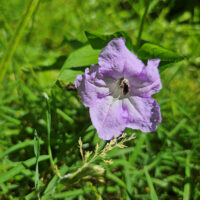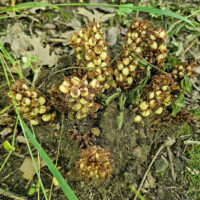 Purdue University - Extension - Forestry and Natural Resources
Purdue University - Extension - Forestry and Natural Resources
Got Nature? Blog
In recognition of Pollinator Week June 16-22, 2025, let’s see what is blooming at Purdue FNR Tippecanoe County property, Martell Forest.
 Wild petunia, Ruellia sp, are several species found in woodland and sunny edge habitats. The blooms do look like the familiar garden petunia, but it is a different genus of plants. I caught small insects inside the flower, evidence of its pollinator value, although I have read the individual flowers may only last one day.
Wild petunia, Ruellia sp, are several species found in woodland and sunny edge habitats. The blooms do look like the familiar garden petunia, but it is a different genus of plants. I caught small insects inside the flower, evidence of its pollinator value, although I have read the individual flowers may only last one day.
 I came upon a unique parasitic plant that does not have chlorophyll or true leaves, but obtains its nutrients by parasitizing oak trees. This is American cancer root, Conopholis americana, also called bear corn, because of the similarity of the plant structure to an ear of corn. Although it lacks chlorophyll, it does possess flowers that propagate the plant.
I came upon a unique parasitic plant that does not have chlorophyll or true leaves, but obtains its nutrients by parasitizing oak trees. This is American cancer root, Conopholis americana, also called bear corn, because of the similarity of the plant structure to an ear of corn. Although it lacks chlorophyll, it does possess flowers that propagate the plant.
 Not far from the cancer root I found fire pink, Silene virginica. This is one flower that would be hard to miss! This is about as red as any native flower encountered in Indiana forests. If you are wondering why pink is in the name instead of red, it is a member of the pink family of plants, which include carnations and a rare prairie relative, royal catchfly. An effort was made a few years ago to make this our state flower, but that has not been acted upon so far.
Not far from the cancer root I found fire pink, Silene virginica. This is one flower that would be hard to miss! This is about as red as any native flower encountered in Indiana forests. If you are wondering why pink is in the name instead of red, it is a member of the pink family of plants, which include carnations and a rare prairie relative, royal catchfly. An effort was made a few years ago to make this our state flower, but that has not been acted upon so far.
 As I headed downhill I came across Virginia spiderwort, Tradescantia virginiana, with beautiful three-petaled violet to blue flowers clustered at the top of the plant. The flowers typically last only a day, but are rapidly replaced by the numerous buds below the current blooms.
As I headed downhill I came across Virginia spiderwort, Tradescantia virginiana, with beautiful three-petaled violet to blue flowers clustered at the top of the plant. The flowers typically last only a day, but are rapidly replaced by the numerous buds below the current blooms.
 Blue-eyed grass, Sisyrinchium sp, was encountered in a grassy area near a tree plantation. This is not a grass but several species that are members of the iris family. The tiny blooms and narrow leaves blend into the grass background.
Blue-eyed grass, Sisyrinchium sp, was encountered in a grassy area near a tree plantation. This is not a grass but several species that are members of the iris family. The tiny blooms and narrow leaves blend into the grass background.
 Some woody plants are blooming in June as well. This is the bell-shaped flower of American persimmon, Diospyros virginiana. Persimmon trees tend to bear either all male or all female flowers on a single tree, but occasionally a tree will have both. Female flowers are solitary on the stems while male flowers tend to be in small clusters.
Some woody plants are blooming in June as well. This is the bell-shaped flower of American persimmon, Diospyros virginiana. Persimmon trees tend to bear either all male or all female flowers on a single tree, but occasionally a tree will have both. Female flowers are solitary on the stems while male flowers tend to be in small clusters.
 The final bloom I have included is rough-leaved dogwood, Cornus drummondii, a shrub relative of the flowering dogwood that provides a white blossom show earlier in the spring. As the name implies, this shrub has leaves with a slightly sandpaper-texture and clusters of small white flowers that are attractive to many pollinators. This blooms later than several other dogwoods, extending the flowering season.
The final bloom I have included is rough-leaved dogwood, Cornus drummondii, a shrub relative of the flowering dogwood that provides a white blossom show earlier in the spring. As the name implies, this shrub has leaves with a slightly sandpaper-texture and clusters of small white flowers that are attractive to many pollinators. This blooms later than several other dogwoods, extending the flowering season.
More about Pollinator Week: this is an annual celebration in support of pollinator health that was initiated and is managed by Pollinator Partnership. It is a time to raise awareness for pollinators and spread the word about what we can do to protect them. Pollinators include bees, butterflies, beetles, moths, wasps, hummingbirds, bats, flies, beetles, lizards, rodents and more.
Resources:
Ask an Expert: What’s Buzzing or Not Buzzing About Pollinators, Purdue Extension – Forestry & Natural Resources (FNR) YouTube Channel
Pollinator Conservation Education, Purdue Extension – Entomology
What’s buzzing in your backyard? Learn about protecting pollinators, beekeeping with Purdue Extension, Purdue Extension News
Indiana Monarch and Pollinator Conservation website
Protecting Pollinators: Protecting Pollinators in Home Lawns and Landscapes, publication, The Education Store, Purdue Extension’s resource center
Consider Pollinators When Planning Your Garden, Got Nature? Blog, Purdue Extension – FNR
Pollinator Conservation Education, Purdue Entomology
Recommended Indiana-Native Plants for Attracting Pollinators (pdf), Purdue Extension – Entomology
Attract Hummingbirds to Your Yard video, Purdue Extension – FNR YouTube Channel
Protecting Pollinators: Biology and Control of Varroa Mites in Bee Hives, The Education Store, Purdue Extension resource center
Gardening for Pollinators, Purdue Garden Articles
Subscribe Purdue Extension-Forestry and Natural Resources YouTube Channel
Lenny Farlee, Extension Forester
Hardwood Tree Improvement and Regeneration Center
Purdue Department of Forestry & Natural Resources

Recent Posts
- A Woodland Management Moment: Black Walnut in Pine Plantation
Posted: December 19, 2025 in Forestry, Forests and Street Trees, Urban Forestry, Woodlands - ID That Tree: Sugarberry
Posted: December 12, 2025 in Forestry, Wildlife, Woodlands - Powering Rural Futures: Purdue’s Agrivoltaics Initiative for Sustainable Growth
Posted: December 9, 2025 in Community Development, Wildlife - Learn How to Control Reed Canarygrass
Posted: December 8, 2025 in Forestry, Invasive Plant Species, Wildlife - Benefits of a Real Christmas Tree, Hoosier Ag Today Podcast
Posted: December 5, 2025 in Christmas Trees, Forestry, Woodlands - Succession Planning Resource: Secure your Future
Posted: December 2, 2025 in Community Development, Land Use, Woodlands - A Woodland Management Moment: Butternut Disease and Breeding
Posted: December 1, 2025 in Forestry, Forests and Street Trees, Woodland Management Moment, Woodlands - Controlling Introduced Cool-Season Grasses
Posted: in Forestry, Invasive Plant Species, Wildlife - Red in Winter – What Are Those Red Fruits I See?
Posted: in Forestry, Plants, Urban Forestry, Wildlife, Woodlands - Managing Common and Cut Leaved Teasel
Posted: November 24, 2025 in Forestry, Invasive Plant Species, Wildlife
Archives
Categories
- Alert
- Aquaculture/Fish
- Aquatic/Aquaculture Resources
- Ask the Expert
- Christmas Trees
- Community Development
- Disease
- Drought
- Forestry
- Forests and Street Trees
- Gardening
- Got Nature for Kids
- Great Lakes
- How To
- Invasive Animal Species
- Invasive Insects
- Invasive Plant Species
- Land Use
- Natural Resource Planning
- Nature of Teaching
- Plants
- Podcasts
- Ponds
- Publication
- Safety
- Spiders
- Timber Marketing
- Uncategorized
- Urban Forestry
- Webinar
- Wildlife
- Wood Products/Manufacturing
- Woodland Management Moment
- Woodlands